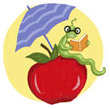|
Teacher’s Guide for
Dinosaur Pizza
by Lee Wardlaw
illustrated by Julie Durrell
(This guide may be reproduced without permission for classroom use.)
About the Book:
When Jill’s best friend moves away, she’s left all alone. Then Bobbi Jo asks her to join the Lunch Bunch, a wacky group of kids who bring different and unusual lunches each day. All these changes can be fun- especially when you wind up eating Dinosaur Pizza!
Pre-reading:
What do you think could possibly be on a dinosaur pizza? Would you eat a slice? Do you pack your lunch or buy it at school? What do you usually bring? Why?
Questions to Consider:
- Why is this year so much harder for Jill?
- Would you want to join the Lunch Bunch? Why or why not?
- What are the rules to be in the club? Do you think they are fair?
- How does Winston decide what to eat? How do you?
- What kinds of foods does Duke like to pack? Do you like any of his choices?
- What does it mean to “swap lunches?” Have you ever swapped something in your lunch?
- What is a PBB? What is your favorite kind of sandwich? Can you make it yourself?
- What do you think Jill put on the dinosaur pizza? What would you put on yours?
- Describe what Jill creates for lunch on Thursday. Is it a success?
- Does Jill decide to stay in the Lunch Bunch Club? What clues do you have?
Projects:
Language Arts:
Create a lunch menu with all your favorite foods on it. Under each of your selections be sure to describe it. If you need inspiration check out menus in fancy restaurants!
Did you notice that Duke only speaks in words that begin with the letter 'Y'? Write a short conversation between two people, in which the one character answers only in one-word sentences that begin with one letter (like the letter “Y”).
Math:
Math for Lunch: If snacks cost .35c and you have a dollar, how many can you get? If cookies are .25c a piece and you have a dollar how many can you buy and share? If milk cost .40c but you want two of them, how much cents should you bring? One lunch bag can feed two people. How many people can eat with four lunch bags? If apples are .30c each and you have a dollar, how many can you buy? Now, with a partner, write five more math questions about lunch.
Food Fractions: Give each child a picture of a pepperoni pizza. Then, using their scissors, have them cut the pie into halves and fourths. Next, have children make PB& J sandwiches (or some other simple alternative) and practice dividing it into thirds.
Art:
Divide a large piece of paper down the middle. Now, create a collage using newspaper ads, grocery store ads and old magazines, cutting out pictures of your favorite foods. On one side glue foods that are good for your body and on the other side glue the ones that aren’t so great. Which side has more pictures? What can you do to have a balanced diet? What foods are good for you?
Health:
As a class, brainstorm a list of blue foods. Why do you think there are so few? Did you know that research has shown that humans are averse to eating foods that are blue? Do you think this is why there aren’t very many? Discuss why color is important in food and which colors kids find most appetizing. (Did you know that the deeper the color the richer the food has in vitamins and minerals?) Homework: brainstorm a list of foods that come in your favorite color!
Science:
Fill out the following K-W-L (Know, Want to know, Learned) graph on dinosaurs. Use books, the library, and the internet (with supervision) to gather facts about what you want to learn about these fascinating animals. Turn your research into a colorful poster and share with your classmates.
What I KNOW
about dinosaurs:
|
What I WANT to know about them:
|
What I LEARNED about dinosaurs:
|
| |
|
|
|
|
|
Just for fun:
Create your own lunch bunch club. Who can be a member? What rules must everyone follow? What crazy foods should each member bring? Have a lunch bunch club Friday where students bring foods of all the same color and then trade to make a complete meal.
This guide was created by Tracie Vaughn Zimmer, a reading specialist and children’s author. To find other guides by Tracie, visit her website: www.tracievaughnzimmer.com |







